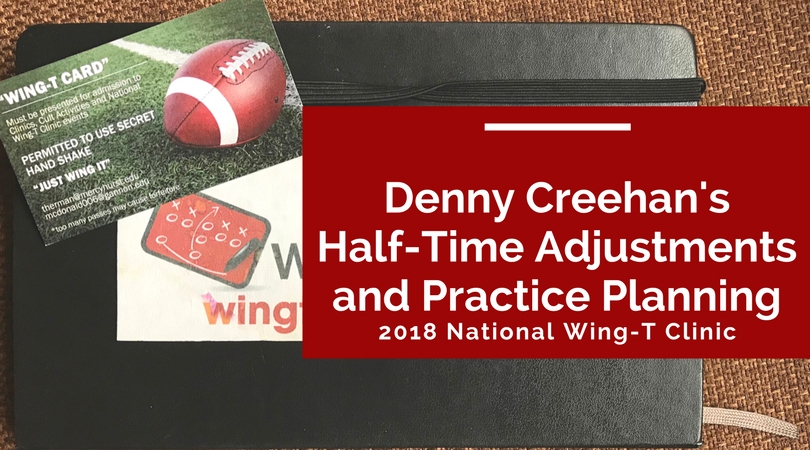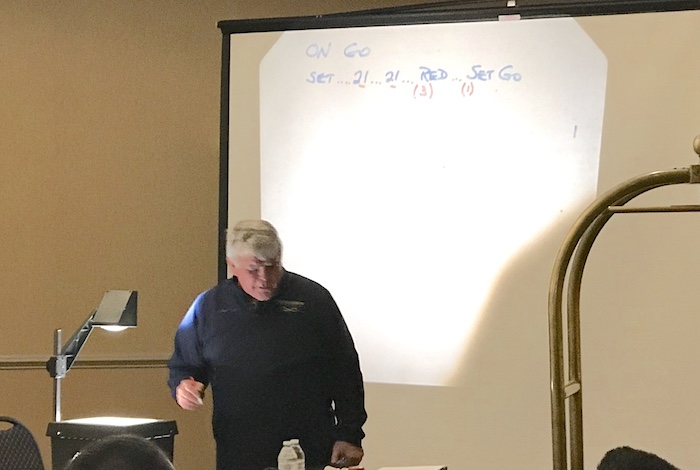Denny Creehan’s Practice Planning and Half-Time Adjustments

I was so excited to see and hear Denny Creehan speak. He’s the author of what I think is the best Wing-T book ever published and I still use his materials as a reference when I’m troubleshooting running plays versus different fronts. While there was good material in his talk, it was probably one of the worst clinics I’ve seen at the National Wing-T Clinic. My issues: the material seemed very recycled from past talks, he didn’t really understand his audience, and his use of manual hand-written transparencies made it hard to visualize what he was talking about. Still, there were some good tidbits there so I’ll break things down.

Pre-Game Planning
By “pre-game” I mean the hours leading up to the game on game day, not during the week prior. His approach is having two white boards at opposite ends of a room large enough to house the entire team, with 11 chairs facing each white board. Offense on one end, defense on the other end, starting players seated with their backup(s) standing behind them.
This is where I rolled my eyes a bit. While I don’t and shouldn’t expect these talks to be relevant to a youth coach, high school coaches are the vast majority of the population. How many of these coaches could pull off an approach like this? I bet less than 5% of the programs represented have completely distinct offense / defense staffs, let alone fully platooned teams segregated by offense and defense.
He broke the final pre-game down into 4 minute segments as follows:
- Bathroom break
- Position coaches
- Coordinator
- Head coach
- Run to field
Half-Time Talks
Coach Creehan has the players sit just like they did during pre-game and uses the same final 20 minute time progression as I showed. The coordinator might steal the head coach time if needed.
Also, special teams might steal the bathroom break time if needed.
He then has the players run to the end zone and back, then breaks out by groups and runs separate drills for each:
- Heavy weights (OL and DT)
- Middle weights (LB, DE, and TE)
- Light weights (RB, DB, and WR)
Race Horse Practice Philosophy
If you’ve read his books, you know about this practice approach. I adopted it years ago and would love to have seen him run a full practice so I could see it in action start to finish. The philosophy centers around:
- Getting maximum repetitions
- A minimum of 2 snaps per minute during team period
- Cross-training players for multiple positions using mass teaching methods
To maximize reps, they do all drills “on sound” and only practice cadence during their clap drill in pre-practice. He recommends not wasting time on cadence for plays until you get to full team.
Cadences
- On Go – Set, 2 digit, 2 digit, Ready, Set-Go. Motions are timed with cadence clap drill.
- On Short Go – Ready, Set-Go.
- On Sound – Set. Go on first sound, no motion plays only.
- On Delayed Go – Set, 2 digit, 2 digit, Ready, Set-Go, Ready, Set-Go.
- On Delayed Short Go – Ready, Set-Go, Ready, Set-Go
- On Delayed Sound – Set, …, Set.
Practice Routine
Coach Creehan starts with a loosen-up period with dynamic warmups, then goes into team takeoff. They will run about 10 yards from the end zone, with backs running out the play and line just firing off. They’ll run two full offense groups at a time, running plays opposite (e.g., buck sweep right for right platoon, buck sweep left for left platoon).
He likes to practice shifts and trades during takeoff period:
- Trade to 121 – just the TE shifts
- Shift to 121 – TE plus the backs shift
- Slide to 121 – TE and SE are on the same side, TE goes across line, backs shift
He then moves into shoulder skills for all players. He’ll use a large bag for every 2 OL, but TE/SE and RBs are also doing this. QBs don’t do shoulder skills or routine footwork - they are instead working on arm loosening and taking snaps with the centers. Shoulder skills involves fitting onto the bag, strike a blow, step and hit, etc.
Next up is routine (footwork) where they focus on stance and initial steps. This involves bird dogging as well as take off drills, including 5 yard sprints to finish.
For the backfield he likes to use spacing boards. Hoses work to, but he likes how the boards will not fold up and twist. Again, you want to maximize reps here by having multiple stations. I’ve gotten mileage out this approach with even a small group, having 1 QB go with the wings / halfbacks, and the other go with fullbacks. Run through footwork with separate coaches with each sub-group, then rotate QBs halfway through. He likes working on handoffs, pitch, and full play work during this period.
At the end of this period he’ll pull TE/SEs over and do passing to include them.